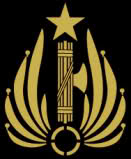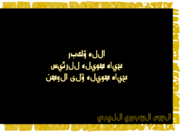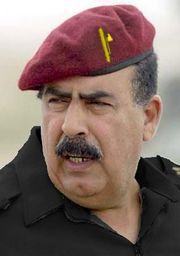Libyan Royal Guard (Kingdom of Italy)
| Libyan Royal Guard | |
|---|---|
|
الحرس الملكي الليبي al'Ḥaris al'Malakiu al'Liybiu | |
 The M.V.S.N. emblem | |
| Active | 1955 - present |
| Branch | Royal Guard |
| Role | Defence force |
| Size | 35,000 |
| Part of | National Royal Guard |
| Headquarters | Tripoli |
| Commanders | |
| Current commander |
Maj. Gen. Nouri Abusahmain |
The Libyan Royal Guard (Arabic: الحرس الملكي الليبي, al'Ḥaris al'Malakiu al'Liybiu, H.M.L.) is the branch of the National Royal Guard tasked to guard and protect the internal security of the United Kingdom of Libya. The al'Ḥaris al'Malakiu, as it is commonly referred to, is the oldest and the largest of the Royal Guards of the realms of the Italian Empire, sometimes being regarded as a true "national" army.
Contents
History
The Libyan Royal Guard descends directly from the Libyan M.V.S.N.; in 1955, only seven years after the establishment of the Italian G.N.R., the Libyan Colonial Militia was merged with other P.N.F. security services, and the Ḥaris al-‘Lybyia al-Jamhariyya was established, even despite the lack of Republican status of the then-colony.
Until recently, the Libyan G.N.R. was commanded by Italian officers, both born and grown up in Libya and coming from Italy. The current Commander is Major General Nouri Abusahmain, the second Commander of Libyan descent after Muammar Muhammad Abu Minyar al-Gaddafi, who was also the first officer of Libyan descent to hold a General rank after being the Chief of Staff with the rank of Colonel; under al-Gaddafi long tenure (1983-2008), Libyan officers could afford for the first time also General ranks. The Ḥaris al-‘Lybyia al-Jamhariyya was deeply involved in the suppression of the UK/USA-backed 2011 revolt and in the subsequent pacification and fight to migration flows from Subsaharian Africa to Northern Africa and the Mediterranean Sea.
In recent years, the H.M.L. provided several instructors and volunteers to the loyalist side of the Syrian Civil War.
Security context
Even after the bloody crackdown on the 2011 uprising, the security situation in Libya is, at best, volatile. The concept of national identity, despite being present in the indigenous urbanised population of the coast, is weak and fragile. Islamist circles do not have militias but are capable of exercising significant influence over the Muslim element.
The Arab or Arabised tribes have an internal cohesion such that they can easily dispose of tribal militias, as well as the numerous kabilas. The Senussites, stirred up and supported by Western powers, remain difficult to completely eradicate and lead a low intensity but nonetheless present opposition. Ethnic minorities such as the Tuareg and Tebu, hostile to the Arab element, are turbulent and have channels for the influx of weapons and ammunition through the Sahara Desert.
The significant Italian presence is concentrated in urban areas in the hinterland or, in general, on the coast. Government power, in this context, tends to rely on two main ethnic elements: the Italian presence and the kabilas, in exchange for favours and concessions from the Government. While the Senussites are resolutely opposed, the black element (Tuareg and Tebu) is used as a prop and, occasionally, as a threat to the kabilas which do not comply with the Government's wishes.
To counter both the power of Islamist influence and the power of influence of the Al-Azhar University, the Libyan government secretly supports the University of Islamic Studies of Benghazi. The Ulemas associated with the University of Islamic Studies support peace and tranquillity, in exchange for the government's adherence to Sharia principles, at least as regards relations between Muslims.
The Libyan Royal Guard, the Militia (recruited mainly from the coastal populations and among the Italians) and the Gendarmerie tend to represent, therefore, the armed arm of the strongest, but not the only, power in the area.
Organization
The H.M.L. is a military force deployed in Libya; the operational forces are organized on two Divisions: the Line Division and the Facilities Defence Division. The main force is the Line Division, in turn based on the Divisional units and five Regiments. Regiments are responsible for specialized training and personnel administration, while subordinate battalions are operationally framed within three Brigades (having Arabic names). Alongside the line Division, also a Facilities Defence Division operates on territorial basis.
Top and support organization
The command and support organization is framed within the H.M.L. Central Command; it groups the General Staff, the Logistics Command, the Training Command and the Support Services Command (all organized at the Brigade level), while administrative duties are dealt with by the Libyan M.V.S.N. The H.M.L. Central Command consists of:
- General Staff;
- General Staff Battalion;
- Logistics and Communications Command;
- Training Command (troops only);
- Military Police and Security Command;
- Support Services Command.
Military Police and Security Command
The Military Police and Security Command is the Libyan Royal Guard organisation tasked to protect politicians, government buildings, and other sensitive sites in Tripoli and throught Libya.
- Honour Guard: the Honour Guard is intended to be a neutral force unaffiliated with any of the factions vying for power in Libya. The Guard has 2,400 troops in Tripoli on different assignments.
- Tripoli Airport Security Battalion.
- Tribal Military Police Battalion.
Line Division
The Line Division is the most well-trained and well-equipped force in the Libyan security apparatus, and the most important security element of the regime. The Division is organized on the Divisional Staff, the Support and Communication Battalions and on five Regiments. The Division consists of:
- Divisional Staff
- Command Battalion "Libia";
- Support Battalion (Medical, Military Police, Supplies, etc.) "Cirenaica";
- Communications Battalion "Tripolitania";
- Training Battalion "Tunisia";
- 1st "Mussolini" Savari Regiment;
- 2nd "Al-Saiqa" Paratroopers Regiment (directly descending from "Fanti dell'Aria" Paratroopers Battalion);
- 3rd "Italo Balbo" Mechanized Infantry Regiment;
- 4th "Ghibli" Mechanized Infantry Regiment;
- 5th "El Alamein" Self-propelled Artillery Regiment.
Operational Brigades
The Line Division is operationally organized into three small Brigades, deployed across the country in few bases in the interior, ready for en masse employment. Each Brigade has a support unit, grouping all support services, a Savari Squadrons Group (Battalion-sized unit), two Infantry Battalions and one Artillery Group, drawn from Regiments.
- 1st Brigade "Ṭarābulus"
- 1st Support Unit "Ṭarābulus"
- 1st Savari Squadrons Group "Faras"
- 1st Mechanized Infantry Battalion "Musha" (1/3)
- 2nd Mechanized Infantry Battalion "Qanas" (2/3)
- 1st Mobile Artillery Group "Medjerda"
- 2nd Brigade "Banghāzī"
- 2nd Support Unit "Banghāzī"
- 2nd Savari Squadrons Group "Diastarih"
- 3rd Mechanized Infantry Battalion "al-Faris" (3/3)
- 4th Mechanizd Infantry Battalion "Ansar" (4/4)
- 2nd Mobile Artillery Group "Targhalat"
- 3rd Brigade "Tūnis"
- 3rd Support Unit "Tūnis"
- 3rd Savari Squadrons Group "Kursr"
- 5th Mechanized Infantry Battalion "Mushat al-Khiala" (5/4)
- 6th Mechanized Infantry Battalion "Jund al-Musadama" (6/4)
- 3rd Mobile Artillery Group "Turghut"
2nd "Al-Saiqa" Paratroopers Regiment
The 2nd "Al-Saiqa" Paratroopers Regiment is both a training/administrative organization and an operational elite unit, being directly subordinated to the Libyan Royal Guard commander and his Staff. The Regiment historically descends from the famed "Fanti dell'Aria" Paratroopers Battalion, established by Italo Balbo in 1939. In the 1990s, al-Saiqa helped to suppress the rebellion of Libyan Islamic Fighting Group. Nowadays, the Regiment shares its training with Italian Army and G.N.R. paratroopers and it is employed to carry out special missions.
The Regiment numbers nearly 3,000 troops and it is based in Brach. The Al-Saiqa Regiment consists of:
- Command;
- Command and Services Company "Al-Saiqa":
- 1st Paratroopers Battalion "Al-Nusar";
- 2nd Commando Battalion "Al-Asad";
- 3rd Battalion "Al-Nnamr": operates secret detention centres.
The incumbent al-Saiqa commander is Colonel Mahmoud al-Werfalli.
Facilities Defence Division
The Facilities Defence Division is mainly tasked with securing and protecting the oil infrastructures to prevent interdiction and theft. It is organized into a Divisional Staff and four Brigade Commands with territorial responsibilities:
- Facilities Defence Division Staff;
- 4th Brigade "Tunisi" (headquartered in Tunis);
- 5th Brigade "Tripoli" (headquartered in Tripoli);
- 6th Brigade "Bengasi" (headquartered in Benghazi);
- 7th Brigade "Fezzan" (headquartered in Sabha).
Each Command has three light infantry battalions and one mobile emergency battalion assigned.
8th Expeditionary Brigade "Sahm"
The 8th Expeditionary Brigade "Sahm" (Arabic for "arrow") is a light brigade designed for action on “mountain-desert terrain”. The formation is the only Italy-aligned combat-oriented regular military unit or formation to employ technicals and to have a vehicle inventory entirely wheeled; its main vehicles are VIC Freccia (IFV), ACTL Iveco SM44 (heavy truck), FIAT Coraggioso M and FIAT Audace M (pickup trucks). The Brigade is tasked to provide resources for peacekeeping, rapid reaction and expeditionary tasks. The main feature of the formation is its stated ability to operate without air support or missile strikes, but only artillery fire against a mobile, maneuvering enemy in his depth to prevent him from making fire contact with its sub-units.
The Brigade was officially established in 2012, and achieved operational capability in 2016. The official aim of the Libyan Royal Guard is to use this formation as both expeditionary/peacekeeping unit and as testbed for a possible conversion of at least one Line Brigade.
Organization
The 8th Expeditionary Brigade "Sahm" is a large Brigade organized on six Battalions:
- 16th Infantry Battalion "Nasir": it operates FIAT Audace M pickup trucks armed with machine guns, grenade launchers, and/or ATGMs as infantry vehicle, complemented with ACTL Iveco SM44 heavy trucks; the mortar battery operates 82mm autonomous self-propelled recoiling mortar system based on FIAT Coraggioso M pickup trucks.
- 7th Mechanized Infantry Battalion "Saqr": it operates Freccia IFVs; the mortar battery operates 82mm autonomous self-propelled recoiling mortar system based on FIAT Coraggioso M pickup trucks.
- 3rd Maneuver Battalion "Thur": it operates 82mm autonomous self-propelled recoiling mortar system based on FIAT Coraggioso M pickup trucks.
- 4th Reconnaissance Squadrons Group "Diktatur": it operates almost only FIAT Audace M pickup trucks.
- 4th Artillery Group "Easifa": it operates towed howitzers, MRLs and anti-tank guns.
- 8th Command and Support Battalion "Taghia": it operates command-staff vehicles and heavy trucks.
Libyan Tribal Militia
The Libyan Tribal Militia (Italian: Militia Tribale Libica; Arabic: الميليشيات القبلية الليبية, al Milishiat al Qabliat al Liybia), also known as the Green Army, is one of the three major M.V.S.N. branches of the Kingdom of Libya. The Libyan Tribal Militia is under the administrative control of the H.M.L. Central Command. It differs from the Libyan Royal Guard in being forged exclusively out of tribal elements loyal to Italy.
The Libyan Tribal Militia has a standing force of 10,000 troops and a tribal militia of some 28,000 Fouj (tribal levies). It serves both as a defence force against external attack and as an Internal security force. It reports directly to the Governmet through the H.M.L. Central Command. The Militia's command structure and communication network are separate from those of the Libyan Royal Guard and the Libyan Gendarmerie.
Its personnel are drawn from tribes loyal to Italy and the King of Libya. It has been described as an institution that ties the tribes to Italy. Its officers command units largely made up of their own tribal cousins, which makes the leaders and their followers less susceptible to subversive ideas and outside ideologies.
Organization
The three regional (Cyrenaica, Fezzan, and Tripolitania) sectors each command one or more motorized battalion amd levies battalions.
- Tripolitania Sector:
- 1st Ceremonial Spahis Squadron
- 1st Motorised Battalion
- 1st Standing Tribal Battalion
- 2nd Standing Tribal Battalion
- Cyrenaica Sector:
- 2nd Motorised Battalion
- 3rd Motorised Battalion
- 3rd Standing Tribal Battalion
- Fezzan Sector:
- 4th Motorised Battalion
- 5th Motorised Battalion
- 4th Standing Tribal Battalion
- 5th Standing Tribal Battalion
The second component of the Libyan Tribal Militia is the Fowj (Arabic: فَيْج) “legman, courier; company”), made up of tribal militia battalions under the command of local sheikhs and chiefs. These men, often the sons of local chiefs, report for duty about once a month for the purpose of receiving stipends. They are provided with rifles. Although neither particularly well trained nor well equipped, they could be counted on to be loyal to Italy if called for service. Their enrollment in the Libyan Tribal Militia is largely a means to bolster the subsidies paid to local sheikhs and to retain the support of their tribes. The Fowj is currently organized into 27 battalions with approximately 27,000 men.
Vehicles
The Libyan Royal Guard is an highly mobile force in order to cover wide areas. Due to the harsh conditions, it also has a certain amount of vehicles placed in reserve.
- 500 x FIAT IVECO "Campagnola" light vehicles;
- 200 x FIAT IVECO "TM" military trucks;
- 150 x OF-40 main battle tanks;
- 150 x FIAT Audace M pickup trucks;
- 100 x ACTL Iveco SM44 heavy trucks;
- 100 x FIAT IVECO self-propelled howitzers;
- 50 x FIAT Coraggioso M pickup trucks;
- 50 x VIC Freccia infantry fighting vehicles.
Uniforms and insignia
Libyan Legionnaires wear their own uniform: green jacket and trousers and matching cap. The blackshirt and the Fascist Eagle are common among all M.V.S.N. branches. Aside of uniform colours, both the cloths' cuts and rank insignia are the same across the Italian Empire.


